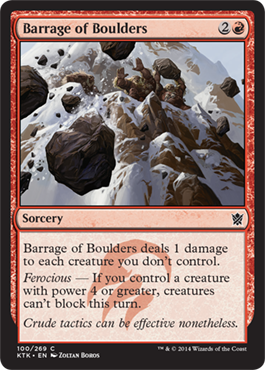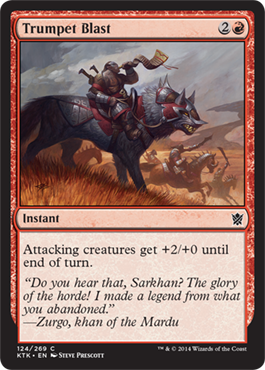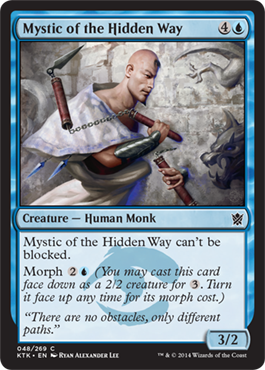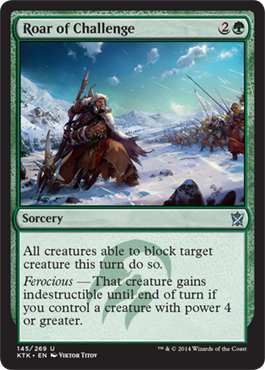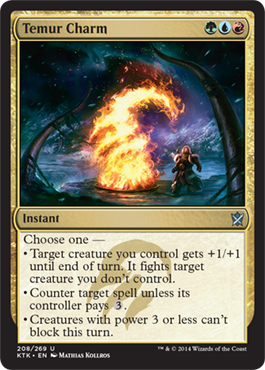Hola, amigos. As you read this, I’ll be driving down to Grand Prix Baltimore with three of my compadres, including recent PTQ crusher Hugh Kramer! While we’re sitting in traffic on I-95, I thought I might provide you with some last-minute GP Baltimore Khans of Tarkir sealed advice.
As we all know, this Limited format—both sealed and, to a lesser extent, draft—is an odd one. At high-level Khans events this past fall, we all know that board stalls have come to define the format. Boards are getting way gummed up, matches are going to time, and it’s not uncommon for players to one-shot their opponents even from life totals as ridiculously high as 21.
I wanted to talk quickly today about the cards that are making that happen—or, more specifically, the common and uncommon cards. Sure, cards like Duneblast, Flying Crane Technique, and Icy Blast are straight-up broken, and you are definitely going to die to these cards over the weekend—but there’s not much you can do about that. If your opponent has them, they kind of often just have them.
This to me is kind of a strike against Khans—cards as nuts as Duneblast and Flying Ninja Apocalypse wouldn’t be necessary if the format didn’t lend itself to hopelessly stalled board states, and if you aren’t lucky enough to get (and be able to play) those cards you are at a disadvantage—but what are you going to do? You can’t—and probably shouldn’t—play around those cards until you’ve seen them.
There are other cards in the set, though, that do reasonable game-ending impressions of these powerful rares, and those are the cards I’m here to talk about today. These are the five cards you see before you die at GP Baltimore. Be aware of these coming from your opponents and—perhaps more importantly, as these cards aren’t the most impressive at face value—I highly recommend looking for these cards in your pool, and finding ways to play them yourself. Because outside of the ivory-billed woodpecker of a perfect aggro sealed deck, you are going to need these cards to close out games—and they will. Here they are, in a mildly particular order:
This is the big one, in my opinion. At GP Orlando I think I played two of this card, and I was happy to have them. Barrage of course pairs very well with many Temur-clan creatures, but you can also get the total falter job done with Bloodfire Expert in Jeskai or Mardu, or even some white or black outlasters (given enough time) in a Mardu deck. Just don’t get greedy like I did once by trying to pump your Scion of Glaciers to go for the Barrage kill if your opponent has mana up. While the card may not be pretty, as its flavor text says, “Crude tactics can be effective nonetheless.”
Trumpet Blast is a little narrower than Barrage, given that it doesn’t remove your opponent’s ability to block—but it makes up for that with the fact that it’s instant-speed. I rarely see this played outside of aggressive Mardu decks, and perhaps rightfully so, but in a deck with big Temur monsters it can also provide the final shot you need, especially paired with tramplers like Snowhorn Rider. I’ve also been on the receiving end of a double Jeskai Windscout beatdown, and on one turn my opponent 10’d me with this card.
This is a simpler, and more fragile, card than the two red spells above, but Mystic of the Hidden Way cares not about your stalled board. In fact, he *loves* a stalled board. Three damage is a quick clock, and if you have managed to stall out the game on the ground (perhaps most likely in a Sultai build, given that blue’s other clans, Jeskai and Temur, are, respectively, less inclined toward withstanding and prolonging board stalls), Mystic is going to get in there for the win if he goes unanswered. His added morph flexibility makes me really want to play two or more of him.
As I mentioned previously, Temur and its giant monsters has less of a problem with board stalls than some of the other clans—but even still, a strong Temur deck can slam up against a wall of outlasters if the Abzan deck has time to get online, or if Sultai puts up a bunch of walls (although Archer’s Parapet doesn’t match up well against Snowhorn Riders and Woolly Loxodons). So anyway, Roar of Challenge functions similarly—but 100% of the time—like Barrage of Boulders; honestly the ferocious clause is kind of irrelevant, outside of some corner cases. I honestly don’t know why I don’t see this card played more often—maybe it’s because it’s uncommon or, as I said, Temur needs it less.
Sneaky, sneaky: Check out that third clause on Temur Charm. Now, unlike Barrage or Roar, Temur Charm isn’t (usually) going to falter your opponent’s whole team. But it will fuck up combat math enough—suddenly taking, say, half your opponent’s blockers out of the game—to get the job done. This pick I will say is more speculative, as I’ve never personally cast this card on its third mode, or had it cast against me, but at a big event like a GP, and a few months into what is now a pretty well-matured format, I think you are rewarded for playing some tricks that your opponents won’t see coming. For instance, on a stalled board I’m definitely going to be keeping Barrage in mind, but I doubt that Temur Charm would even occur to me. I advise you to keep it in mind.
One final note: You might notice that Rush of Battle isn’t on this list. The reason why is that, unlike the five cards above, Rush is rarely ever going to just one-shot you, because A) it’s a sorcery and B) it doesn’t falter. That’s not to say that Rush is a bad card—in the right (warriors) deck it can be very good—but I do think it’s kind of bad at breaking board stalls, which by definition are filled with (often high-toughness) blockers who can absorb a big, Rush-fueled shot. Of course, Rush can be a fantastic nail in the coffin in an aggro deck, but in my mind it’s not really a stall-breaker.
Good luck at GP Baltimore this weekend, everybody! If you see me at the event, be sure to say hi! I’ll see you guys in the Top 8 on Sunday. 😉
23/17 is a Hipsters of the Coast column focused on Limited play—primarily draft and sealed, but also cubing, 2HG, and anything else we can come up with. The name refers to the “Golden Ratio” of a Limited deck: 23 spells and 17 lands. Follow Hunter at @hrslaton.


